This laboratory manual serves as a comprehensive guide for undergraduate biology courses, providing foundational knowledge and practical skills through hands-on experiments and detailed explanations. It aligns with course objectives, emphasizing scientific inquiry and critical thinking in biological principles.
1.1 Purpose and Structure of the Manual
This laboratory manual is designed to guide students through hands-on experiments and activities that reinforce key biological concepts. Its primary purpose is to provide a structured framework for exploring fundamental biological principles, ensuring a comprehensive understanding of the subject. The manual is organized into clear sections, each focusing on specific topics such as cell biology, genetics, ecology, and microscopy. Each chapter includes detailed procedures, safety protocols, and expected outcomes to help students navigate lab sessions effectively. The structure encourages active learning, critical thinking, and scientific inquiry, preparing students for advanced studies in biology. By following the manual, students will gain practical skills and a deeper appreciation for the biological sciences, fostering a solid foundation for their academic and professional careers.
1.2 Preparing for Lab Sessions
Preparation is essential for effective and safe participation in lab sessions. Begin by thoroughly reviewing the lab manual and understanding the objectives, materials, and procedures. Organize all required materials, such as lab coats, gloves, and goggles, to ensure compliance with safety protocols. Familiarize yourself with the location of emergency equipment, including fire extinguishers, eyewash stations, and first aid kits. Review any necessary pre-lab readings or videos to grasp key concepts and techniques. Ensure your workspace is clean and well-organized to minimize distractions and hazards. Finally, arrive promptly and follow all instructor guidelines to maximize learning and maintain a safe environment for everyone involved in the lab session.
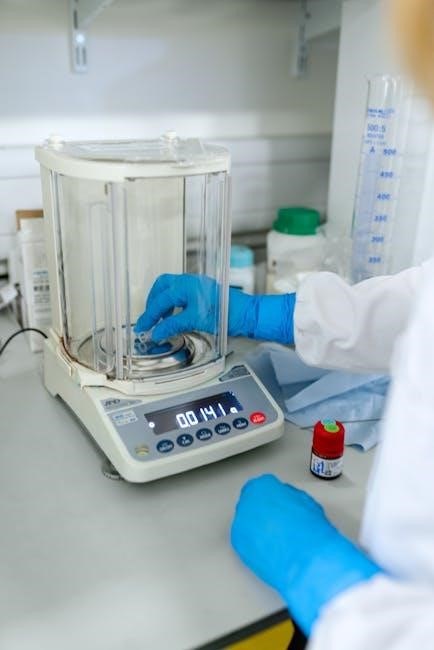
Lab Safety and Regulations
Laboratory safety is crucial to protect personnel and ensure compliance with regulations. Always wear appropriate PPE, follow proper chemical handling, and know emergency procedures to maintain a safe environment.
2.1 General Lab Safety Rules
Adhering to lab safety rules is essential to prevent accidents and ensure a secure environment. Always wear appropriate personal protective equipment (PPE), such as lab coats, gloves, and goggles, when handling chemicals or biological specimens. Tie back long hair, secure loose clothing, and avoid wearing jewelry that could pose a hazard. Closed-toe footwear is mandatory, and sandals or open-toed shoes are prohibited. Never eat, drink, or chew gum in the lab. Familiarize yourself with the location of emergency equipment, such as fire extinguishers, eyewash stations, and first aid kits. Follow proper procedures for handling and disposing of chemicals, and attend all required safety briefings before starting experiments. Ignorance of these rules can lead to serious injuries or legal consequences.
2.2 Emergency Procedures and Equipment
In case of emergencies, knowing proper procedures and equipment locations is crucial. Fire extinguishers, eyewash stations, first aid kits, and emergency exit routes must be easily accessible and clearly marked. Activate the lab alarm and evacuate the area immediately if a fire or chemical spill occurs. Use fire extinguishers only if the fire is small and you are trained. For chemical exposure, flush affected areas with water for at least 15 minutes using an eyewash station. Report all incidents to the instructor or lab supervisor. Regular safety drills ensure preparedness. Familiarize yourself with emergency equipment during lab orientations. Prompt action can prevent minor incidents from escalating, ensuring safety for everyone in the lab environment. Proper training and awareness are key to effective emergency response.

Microscopy in Biology Labs
Microscopy is essential for studying tiny biological structures. Compound light microscopes provide detailed cellular views, while stereo microscopes are used for dissecting and observing larger specimens or tissues.
3.1 Using the Compound Light Microscope
The compound light microscope is a fundamental tool in biology labs, enabling detailed observation of cellular structures. It consists of an eyepiece, objective lenses, a stage, and a light source. To use it, prepare the microscope by cleaning the lenses with lens paper and adjusting the light source. Place the slide on the stage, secure it with the stage clips, and focus using the coarse and fine adjustment knobs. Start with low magnification (e.g., 4x or 10x) to locate the specimen, then switch to higher magnification (e.g., 40x or 100x oil immersion) for detailed observation. Adjust the condenser lens for optimal light clarity. Proper handling ensures clear visualization of biological samples, making it essential for studying cellular structures and functions.
3.2 Stereo Microscope Techniques
The stereo microscope, also known as a dissecting microscope, provides a three-dimensional view of specimens, making it ideal for observing larger samples like tissues, insects, and small organisms. Unlike the compound microscope, it uses two separate optical paths, allowing for depth perception. To use it effectively, place the specimen on the stage and adjust the light source for proper illumination. Use the zoom feature to magnify the sample without changing objectives, and adjust the interpupillary distance and diopter settings for comfortable viewing. Stereo microscopes are essential for dissections, examining external structures, and studying specimen morphology. They are often used in ecology and anatomy labs to analyze whole organisms or tissues without the need for sectioning. Proper technique enhances the clarity and detail of the observed specimen, aiding in accurate biological investigations and descriptions.
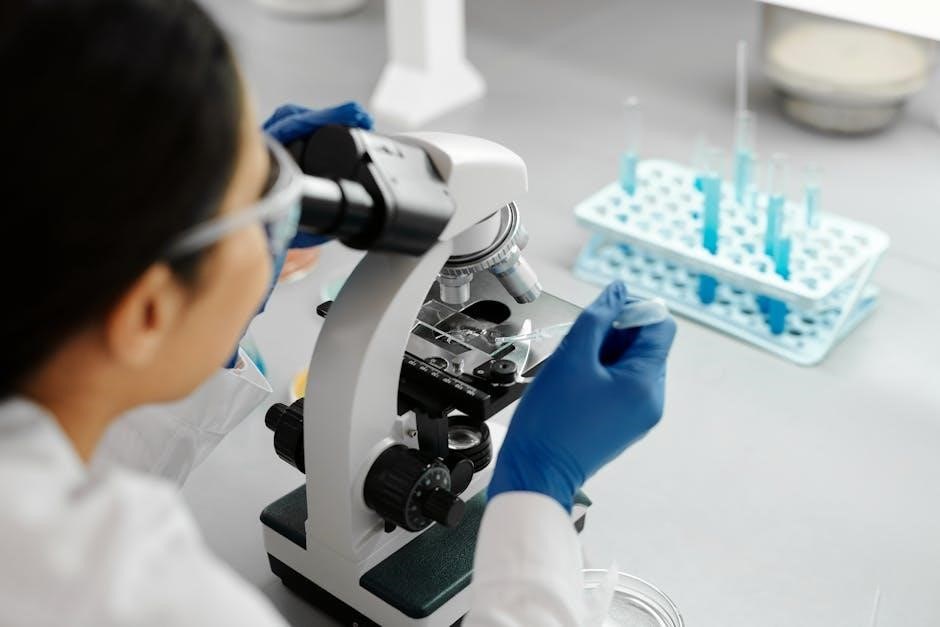
Cell Biology Experiments
Explore cellular structure and function through hands-on activities. Observe live cells, study cell division, and investigate transport mechanisms, enhancing understanding of biological processes at the cellular level.
4.1 Observing Cell Structure and Function
This section focuses on understanding the morphology and function of cells through microscopy. Students learn to prepare and observe slides of plant and animal cells, identifying key structures such as the cell wall, plasma membrane, cytoplasm, nucleus, and organelles. Techniques include staining methods to enhance visibility under a compound light microscope; Observations of living cells and fixed specimens provide insights into cellular dynamics. Additionally, experiments on cell division and organelle function are conducted to explore how cells maintain life, grow, and respond to stimuli. These activities bridge theoretical knowledge with practical skills, fostering a deeper appreciation of cellular biology and its significance in broader biological processes.
4.2 Investigating Cellular Transport Mechanisms
This section explores the movement of materials across cellular membranes, focusing on passive and active transport mechanisms. Experiments include demonstrations of diffusion, osmosis, and active transport using artificial membranes or living cells. Students observe how substances like glucose, ions, and water cross membranes, analyzing factors such as concentration gradients and membrane permeability. Techniques involve measuring transport rates, observing plasmolysis, and using indicators to track movement. These activities provide insights into how cells maintain homeostasis and respond to environmental changes. Practical exercises reinforce theoretical concepts, enabling students to understand the critical role of transport mechanisms in cellular function and overall organismal survival.
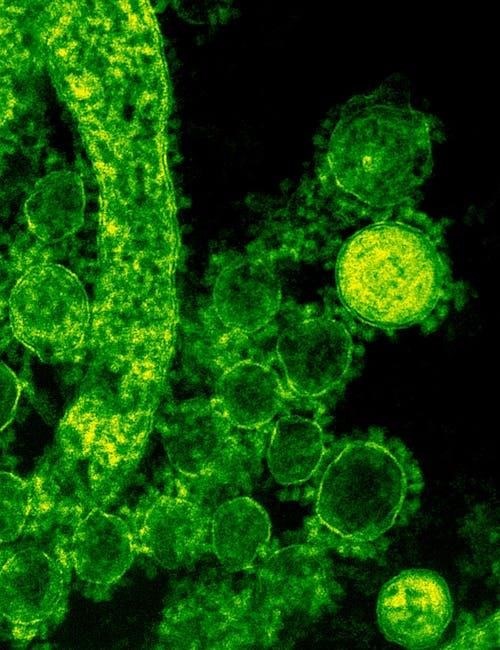
Genetics and Heredity
This section introduces fundamental principles of genetics, exploring inheritance patterns, Mendelian laws, and DNA structure. Practical exercises involve analyzing pedigrees and simulating genetic crosses to understand hereditary traits.
5.1 Mendelian Genetics and Inheritance Patterns
This section explores the fundamental principles of Mendelian genetics, focusing on inheritance patterns and laws of segregation and independent assortment. Students engage in hands-on activities, such as creating Punnett squares and analyzing pedigree charts, to predict and understand genetic outcomes. Practical exercises include simulating monohybrid and dihybrid crosses to observe phenotypic ratios. Data interpretation and statistical analysis are emphasized to validate Mendel’s laws. Additionally, the section introduces basic genetic terminology and the role of alleles in determining traits. By combining theoretical concepts with experimental approaches, students gain a deeper understanding of how genetic information is passed through generations.
5.2 DNA Structure and Replication
This section delves into the molecular structure of DNA, emphasizing its double-helix model and the roles of nucleotides, sugars, and phosphates. Lab activities include modeling DNA replication using physical structures and simulating the process of semi-conservative replication. Students explore the functions of key enzymes such as DNA polymerase and ligase, as well as the differences between leading and lagging strand synthesis. Practical exercises involve extracting and visualizing DNA, while theoretical discussions cover the significance of DNA replication in genetic continuity. Data analysis and interpretation of experimental results are integrated to reinforce understanding of DNA’s central role in heredity. This section bridges theoretical concepts with hands-on experimentation to deepen comprehension of DNA’s structure and replication mechanisms.

Ecology and Ecosystems
This section explores the structure and function of ecosystems, focusing on energy flow, nutrient cycles, and interactions between biotic and abiotic components. Lab exercises include field observations, species sampling, and ecosystem modeling to understand ecological principles and biodiversity. Students analyze data to interpret environmental impacts and ecological balance.
6;1 Ecosystem Structure and Components
An ecosystem consists of biotic (living) and abiotic (non-living) components that interact to form a functional unit. Biotic components include producers (plants, algae), consumers (herbivores, carnivores), and decomposers (bacteria, fungi). Abiotic factors such as light, temperature, water, and nutrients play a critical role in shaping ecosystem dynamics. Laboratory exercises focus on identifying and analyzing these components, exploring energy flow through food webs, and understanding nutrient cycling processes. Students learn to classify organisms, measure environmental parameters, and assess the impact of human activities on ecosystem balance. Practical activities include field observations, species sampling, and experiments to demonstrate ecological principles. This section provides hands-on experience in understanding the intricate relationships within ecosystems.
6.2 Population Dynamics and Interactions
Population dynamics involve the study of factors influencing population size, such as birth rates, death rates, immigration, and emigration. Laboratory exercises explore these concepts through simulations and data analysis, enabling students to understand how populations grow, stabilize, or decline over time. Interactions between species, including predator-prey relationships, competition, and symbiosis, are also examined. Practical activities include modeling population growth curves, analyzing species interactions in controlled environments, and interpreting ecological data. These exercises provide insights into how environmental changes and biological interactions shape community structures. By engaging in hands-on experiments and observations, students develop a deeper understanding of the complex dynamics within ecosystems and their implications for biodiversity and ecological balance.
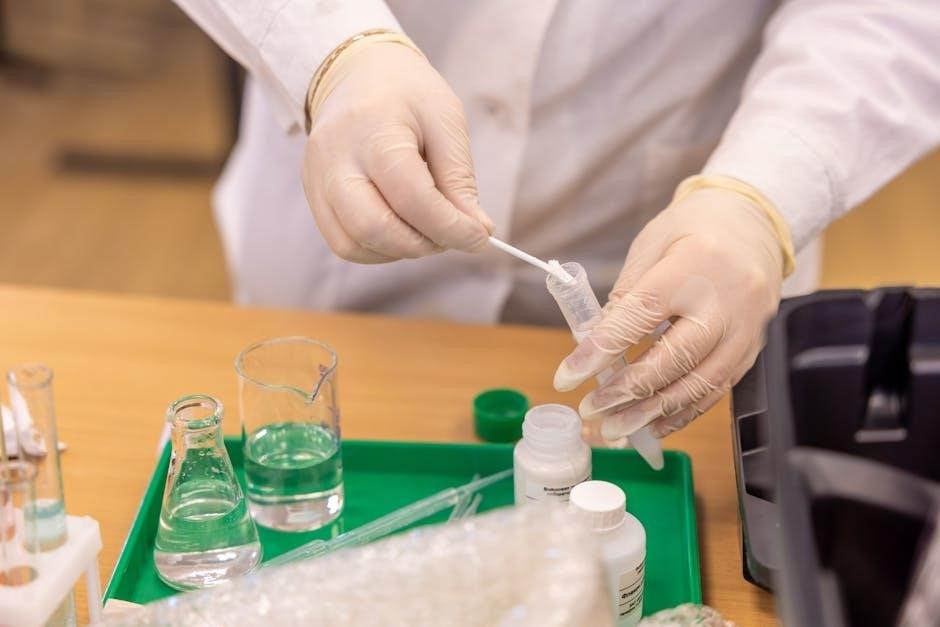
Evolution and Natural Selection
This section explores the fundamental concepts of evolution and natural selection through hands-on activities and observations. Students analyze evidence supporting evolutionary processes, such as fossil records, genetic variations, and adaptations. Practical experiments simulate natural selection pressures, enabling students to understand how populations evolve over time. Key topics include mechanisms of speciation, evolutionary fitness, and the role of environmental factors in shaping biodiversity. These exercises foster a deeper appreciation of evolutionary biology and its relevance to understanding life’s diversity and complexity.
7.1 Mechanisms of Evolution
This section delves into the primary mechanisms driving evolutionary change, focusing on natural selection, genetic drift, mutation, and gene flow. Laboratory exercises simulate these processes, allowing students to observe how populations adapt over generations. Natural selection is explored through experiments demonstrating how environmental pressures favor certain traits, leading to increased fitness. Genetic drift is illustrated using simulations that reveal the impact of random chance on allele frequencies. Mutations are examined as a source of genetic variation, while gene flow activities highlight the importance of population dynamics in maintaining diversity. These hands-on investigations provide a foundational understanding of how evolutionary mechanisms shape biodiversity and species adaptation. Practical data analysis reinforces theoretical concepts, enabling students to critically assess evolutionary outcomes.
7.2 Evidence of Evolution in Laboratory Experiments
Laboratory experiments provide tangible evidence of evolutionary processes, allowing students to witness adaptation and speciation in controlled settings. Activities include the evolution of antibiotic resistance in bacteria, demonstrating natural selection in action. Students observe how environmental pressures drive trait selection, such as pesticide resistance in insect populations. Phylogenetic analysis using molecular techniques reveals evolutionary relationships among organisms. Additionally, simulations of fossil records and comparative anatomy experiments highlight morphological changes over time. These experiments offer empirical support for evolutionary theory, enabling students to analyze data and draw conclusions about the mechanisms and outcomes of evolution. By replicating historical studies, learners gain a deeper appreciation for the scientific evidence underpinning modern evolutionary biology.
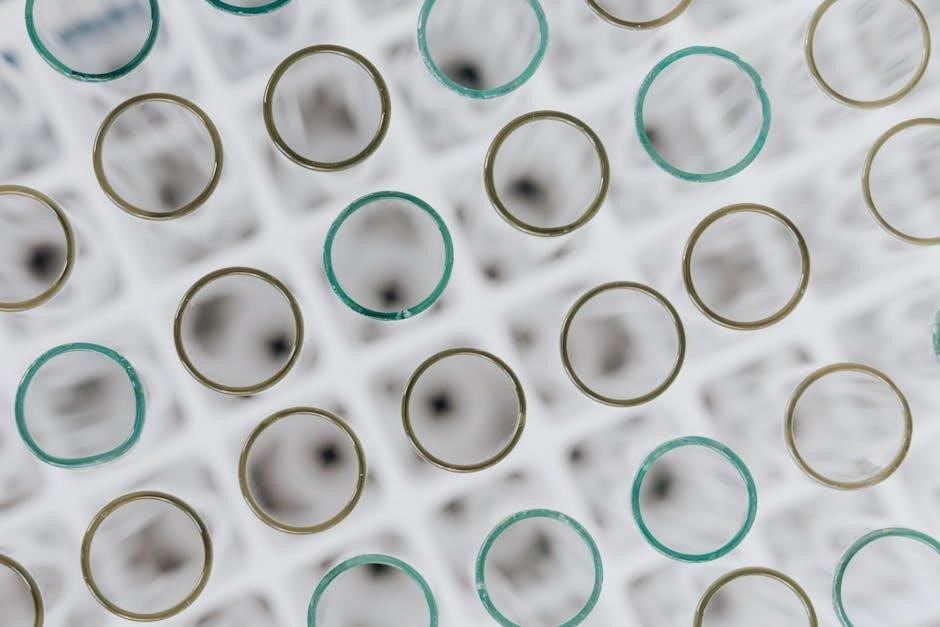
Practicum in Biological Techniques
This section focuses on advanced practical applications, including dissection, histology, and ecology field studies. Students develop hands-on skills in biological procedures and apply theoretical knowledge in real-world contexts.
8.1 Dissection and Histology
Dissection and histology exercises provide hands-on experience with anatomical structures and tissue analysis. Students learn to identify organs and systems in various organisms, such as frogs, worms, and plants. Histology involves preparing and staining tissue samples for microscopic examination, enabling the study of cellular arrangements and functions. These activities reinforce anatomical concepts and develop precision skills. Safety protocols and proper use of dissecting tools are emphasized. Through these exercises, students gain a deeper understanding of biological structures and their roles in overall organism function. This practical experience is essential for applying theoretical knowledge in real-world biological studies and research.
8.2 Ecology Field Studies and Observations
Ecology field studies and observations enable students to explore natural environments, collecting data on diverse ecosystems. These activities emphasize understanding interactions between organisms and their habitats. Students conduct species surveys, measure environmental factors like pH and temperature, and analyze nutrient cycling. Fieldwork fosters observation skills and the ability to interpret ecological patterns. By documenting biodiversity and community structures, students apply ecological principles to real-world scenarios. These hands-on experiences promote environmental awareness and reinforce classroom concepts, preparing students for careers in conservation and ecological research. Field studies also encourage critical thinking and teamwork, essential for addressing complex environmental challenges.

Assessment and Evaluation
This section outlines the methods for evaluating student understanding and lab performance, including grading criteria for reports, practical exams, and competency tests. Feedback is provided to improve skills.
9.1 Lab Reports and Data Analysis
Lab reports are critical for documenting experimental procedures, results, and conclusions. They must include materials, methods, data, and discussions. Proper formatting and clarity are essential for accurate communication. Data analysis involves interpreting results, often using graphs and tables to visualize trends. Students are evaluated on their ability to draw logical conclusions and relate findings to biological concepts. Peer and instructor feedback helps refine reporting skills. Adherence to scientific writing standards ensures professionalism and reproducibility. This section provides guidelines for structuring reports and performing statistical analyses to enhance understanding and critical thinking in biological experiments.
9.2 Practical Exams and Competency Tests
Practical exams and competency tests assess students’ hands-on skills and understanding of laboratory techniques. These evaluations simulate real-world scenarios, requiring precise execution of methods and accurate data interpretation. Competency tests focus on specific skills like microscopy, dissection, and experimental design. Practical exams often include stations where students demonstrate tasks under timed conditions. Feedback from instructors helps identify strengths and areas for improvement. High scores reflect mastery of biological techniques essential for future scientific endeavors. These assessments ensure students are well-prepared for advanced lab work and professional environments, emphasizing practical application of knowledge gained throughout the course.
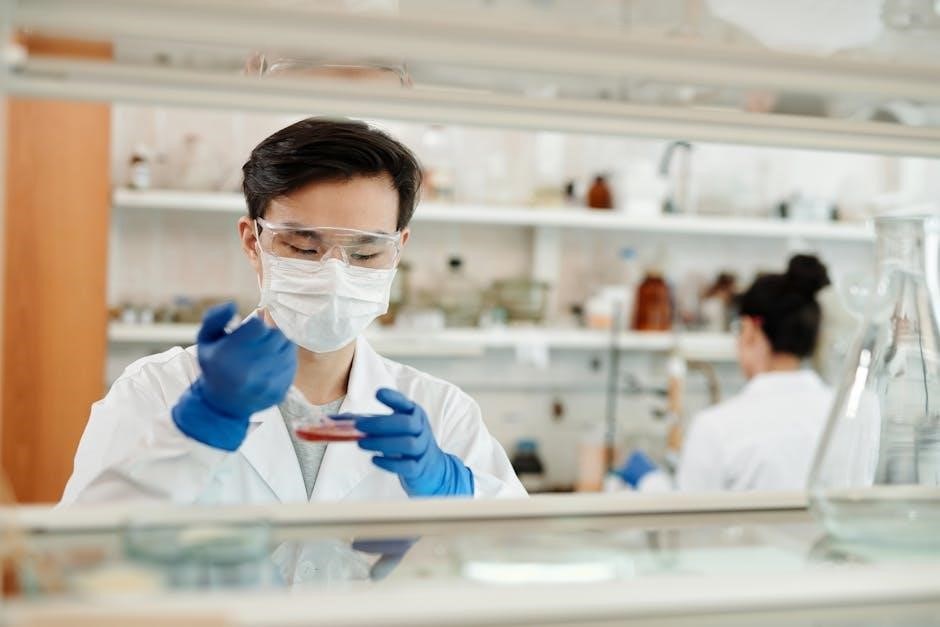
This manual provides a comprehensive foundation in general biology, equipping students with essential skills and knowledge for future academic and professional pursuits in the biological sciences.
10.1 Summary of Key Concepts and Skills
This laboratory manual for general biology has provided a thorough exploration of fundamental biological concepts and practical skills. Students have gained hands-on experience with microscopy, cell structure analysis, and genetic principles. Key skills include laboratory safety, data collection, and scientific reporting. The manual emphasizes critical thinking and scientific inquiry, preparing students for advanced studies in biology. Practical techniques such as dissections, histology, and ecological field observations have been mastered. Understanding of cellular transport, DNA structure, and evolutionary mechanisms has been reinforced. This comprehensive approach ensures students are well-equipped with both theoretical knowledge and practical expertise, essential for pursuing careers in biological sciences.
